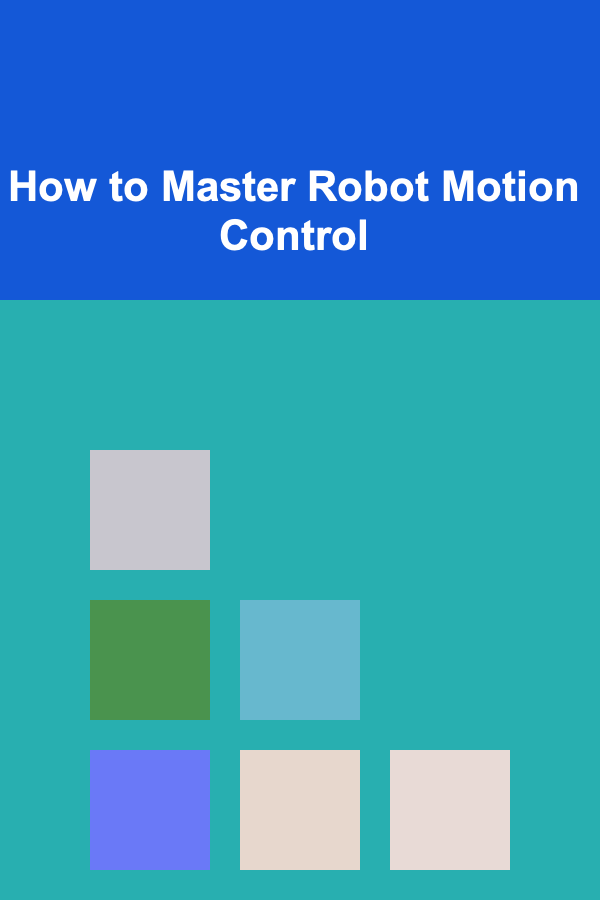
How to Master Robot Motion Control
ebook include PDF & Audio bundle (Micro Guide)
$12.99$10.99
Limited Time Offer! Order within the next:

Robot motion control is an essential component of modern robotics, playing a critical role in the functionality, accuracy, and versatility of robotic systems. As robotics continues to evolve, mastering robot motion control has become increasingly important for engineers, researchers, and enthusiasts alike. Whether you're working with industrial robots, drones, or autonomous vehicles, understanding the principles behind robot motion control is crucial to optimizing performance, ensuring safety, and achieving the desired outcomes.
This article will explore the fundamentals of robot motion control, the various types of control systems, algorithms, and sensors involved, and the latest advancements in the field. By the end, you'll have a comprehensive understanding of the techniques and technologies that make robot motion control possible and how to master them effectively.
What is Robot Motion Control?
Robot motion control refers to the process of managing a robot's movement through precise control mechanisms. This process involves the coordination of various actuators, sensors, and feedback loops to achieve accurate and repeatable movement in a specific environment. The goal of motion control is to ensure that a robot performs its intended task efficiently, safely, and with minimal error.
Motion control is critical in various robotic applications, such as manufacturing, exploration, medical procedures, and more. Whether it's a robotic arm used in a factory or a self-driving car navigating through traffic, motion control ensures that the robot behaves in a controlled, predictable manner.
Key Concepts in Robot Motion Control
1. Kinematics
Kinematics is the study of motion without considering the forces that cause it. It focuses on the position, velocity, and acceleration of the robot's components. The kinematics of a robot describe how the robot's joints and links move in relation to one another.
In robot motion control, the kinematic model is crucial in determining the position and orientation of the end-effector (the part of the robot that interacts with the environment, such as a robotic hand or a camera) given the joint parameters. The kinematic equations describe the relationship between joint movements and end-effector motion.
There are two main types of kinematics:
- Forward Kinematics (FK): Given the joint angles, FK calculates the position of the end-effector.
- Inverse Kinematics (IK): Given the desired position of the end-effector, IK calculates the required joint angles.
Inverse kinematics is typically more complex than forward kinematics because there are multiple possible solutions, or no solution, depending on the robot's geometry.
2. Dynamics
While kinematics deals with motion without considering forces, dynamics is the study of motion considering the forces and torques that cause it. In robot motion control, dynamics helps predict how a robot will behave in response to forces and how those forces can be controlled.
Dynamic modeling is essential for robots that must perform precise tasks under varying loads, such as surgical robots or industrial robots that manipulate heavy objects. The robot's dynamic model takes into account the mass, inertia, and forces acting on its components. By understanding these dynamics, engineers can design controllers that compensate for external forces, improving the robot's performance.
3. Control Systems
Control systems are used to regulate a robot's motion. There are different types of control systems in robotics, each serving a specific purpose depending on the complexity of the task and the environment in which the robot operates. The two most common types of control are:
- Open-loop Control: In open-loop systems, the control actions are based solely on the input command, with no feedback from the robot's environment. This type of control is simple and works well in predictable environments but is less accurate in complex, uncertain conditions.
- Closed-loop Control (Feedback Control): In closed-loop control systems, the robot continuously receives feedback from sensors and adjusts its motion accordingly. This feedback loop ensures that the robot can adapt to changes in its environment, making closed-loop control systems more accurate and reliable.
Feedback control systems can be further divided into:
- Proportional-Integral-Derivative (PID) Control: One of the most widely used control algorithms. PID controllers adjust the robot's motion based on the proportional, integral, and derivative terms of the error between the desired and actual positions.
- Model Predictive Control (MPC): MPC uses a model of the robot and its environment to predict future movements and optimize the control inputs.
4. Actuators and Sensors
Robots use actuators to generate motion and sensors to perceive their environment. The combination of actuators and sensors enables the robot to execute precise movements while responding to real-time changes in its surroundings.
- Actuators: These are devices that convert energy into mechanical motion. The most common actuators used in robots are electric motors, pneumatic actuators, hydraulic actuators, and piezoelectric actuators. Each type of actuator has its own advantages and limitations, depending on the robot's application.
- Sensors: Sensors provide feedback to the control system, enabling the robot to adjust its motion. Common sensors used in motion control include encoders (for measuring rotational displacement), accelerometers (for measuring acceleration), gyroscopes (for measuring angular velocity), and force/torque sensors (for measuring the forces applied to the robot).
By continuously monitoring and responding to sensor data, the robot can adjust its motion and remain on track, even in dynamic environments.
Types of Robot Motion Control
1. Point-to-Point (PTP) Motion Control
Point-to-Point motion control involves moving the robot from one point to another without focusing on the path taken. This is often used in tasks like pick-and-place operations, where the robot needs to move an object from one location to another, but the exact trajectory is less important than reaching the destination.
The robot's motion is typically controlled in discrete steps, where the system calculates the optimal path to move between points. PTP control is simple and fast but may not be suitable for applications requiring precise trajectory control or smooth motion.
2. Continuous Path Motion Control (CP)
In contrast to PTP, Continuous Path motion control ensures that the robot follows a smooth, continuous path from one point to another. This is critical for applications like painting, welding, or 3D printing, where the tool must move along a specific trajectory.
CP control systems are typically more complex, as they need to account for the robot's velocity, acceleration, and deceleration while ensuring that the robot follows the prescribed path with high accuracy.
3. Trajectory Planning and Control
Trajectory planning and control involve calculating and executing a desired path for the robot's movement, often involving sophisticated algorithms to optimize the motion based on time, energy, and constraints such as obstacle avoidance.
In trajectory planning, the goal is to find a path from an initial position to a target position while satisfying physical constraints like joint limits, velocity limits, and obstacle avoidance. Once the trajectory is planned, a motion control system is used to follow it accurately.
Algorithms for Robot Motion Control
Several algorithms are used in robot motion control, each designed for different types of robots and tasks. Some of the most common algorithms include:
- Inverse Kinematics Algorithms: As mentioned earlier, inverse kinematics is crucial for determining the joint configurations that will allow the robot to achieve a specific position. There are various numerical methods for solving inverse kinematics, such as Newton-Raphson or Jacobian-based methods.
- Path Planning Algorithms: These algorithms are used to determine the best path for the robot to follow. Algorithms like A*, Dijkstra's algorithm, and Rapidly-exploring Random Trees (RRT) are commonly used for path planning, especially in environments with obstacles.
- Motion Planning Algorithms: Motion planning involves not only determining a path but also ensuring that the robot moves smoothly and efficiently, avoiding obstacles and following the trajectory. Some advanced motion planning algorithms include RRT*, Probabilistic Roadmaps (PRM), and Sampling-based algorithms.
Advanced Topics in Robot Motion Control
1. Multi-Robot Systems
In some applications, it's necessary to control multiple robots simultaneously. Coordinating the movement of multiple robots involves complex motion control techniques, such as multi-agent systems and swarm robotics.
In multi-robot systems, robots must be able to communicate with each other and synchronize their movements to avoid collisions and optimize task performance. Distributed control algorithms, such as consensus algorithms, are used to achieve coordination in these systems.
2. Learning-Based Control
With the rise of machine learning, learning-based control methods are being increasingly integrated into robot motion control. Reinforcement learning (RL) and deep learning can be used to improve robot performance by allowing the robot to learn from experience rather than relying solely on pre-programmed algorithms.
For example, in reinforcement learning, the robot learns by receiving feedback from its environment. The robot improves its control policy by maximizing a reward function that is based on its performance in the task.
3. Soft Robotics
Soft robotics is a rapidly growing field that focuses on creating robots made from flexible, deformable materials. Soft robots require different motion control techniques than traditional rigid robots, as they can change shape and adapt to their environment.
Controlling the motion of soft robots involves developing algorithms that can handle continuous deformation, as well as new types of sensors and actuators. Soft robotics has many potential applications, from medical devices to search-and-rescue robots.
Conclusion
Mastering robot motion control is a complex and multifaceted task, requiring a deep understanding of kinematics, dynamics, control systems, and algorithms. By mastering these concepts, you can optimize the performance, accuracy, and reliability of robots across a wide range of applications.
As robotics continues to advance, so too does the field of motion control. With the advent of machine learning, multi-robot coordination, and soft robotics, the future of motion control is incredibly exciting. By staying informed about the latest trends and continuously refining your skills, you can stay at the forefront of this dynamic field and contribute to the next generation of robotic innovations.
Mastering robot motion control is not just about understanding theory but also about practical implementation. By experimenting with real-world robots and gaining hands-on experience, you'll be better equipped to tackle the challenges of robot motion control and unlock the full potential of robotic systems.

Building Stronger Teams: Tactics for Supervisors in Charge
Read More
How to Get Started with Bungee Jumping
Read More
How to Use Clear Containers for Better Craft Visibility
Read More
How to Use Essential Oils in Your Cleaning Routine for a Fresh Aroma
Read More
How To Succeed in The Job Search Process from Start to Finish
Read More
Choosing the Right Foam Cannon for Efficient Car Washing
Read MoreOther Products

Building Stronger Teams: Tactics for Supervisors in Charge
Read More
How to Get Started with Bungee Jumping
Read More
How to Use Clear Containers for Better Craft Visibility
Read More
How to Use Essential Oils in Your Cleaning Routine for a Fresh Aroma
Read More
How To Succeed in The Job Search Process from Start to Finish
Read More